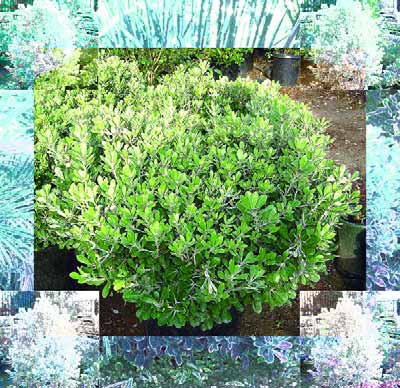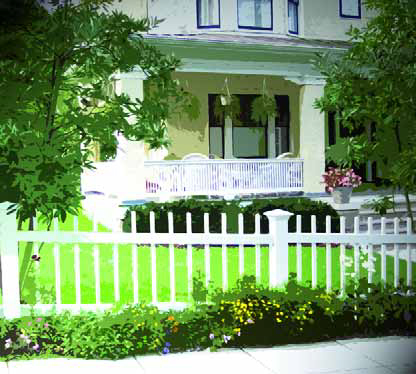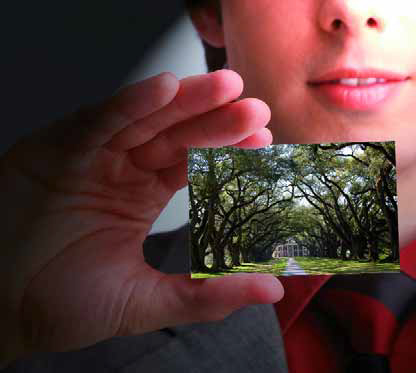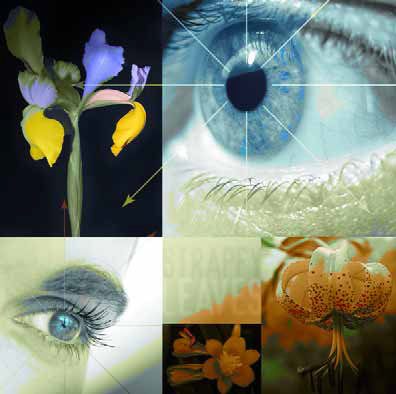Natural Companions
As designers, we learn to evaluate landscapes and watershapes with critical eyes, deciding if we like a plant palette, for example, or if a hardscape makes sense or a watershape is sited properly in a yard. These critical skills are important, because clients hire us to pull all of those elements together and develop solutions that suit their needs as well as those of the setting. On rare occasions, a design/build project will stay on a straight course from initial concept to execution. Usually, however, I know that any ideas or biases I carry onto a job site will change and become more complex as I get to know my clients' wants, needs and desires. In other words, my critical skill - my designer's point of view - is consistently
When I paint, I constantly play with color on canvas and experiment with various combinations to see what works well and discover what, to my eye, clashes or doesn't seem to mix harmoniously. As a landscape designer, I'm aware of working through the same sort of process when I discuss color with clients - determining their likes and dislikes and narrowing the color palette down to those hues, values and intensities that are most appealing to them. Some aren't even aware until I launch into a discussion with them that they have particular tastes involving the color wheel. In my experience, all these clients lean
In looking back over several recent projects, I noticed that I've been using one particular genus of plants more frequently than just about any other. Its name probably evokes thoughts of petri dishes and bacterial colonies for most of us, but this plant genus - Pittosporum - has truly held an extremely valuable position in most of my plant palettes in recent years and is one of the most useful of all plant types I use. I find myself pointing them out every time I take clients to a nursery to view and select plants, and it seems I'm always trying to find ways to fit one or more of its many varieties into my planting plans. I treasure them for their great variety in
Although my practice primarily encompasses residential landscapes, I occasionally tackle a commercial project. In one such case, I was recently asked to design the entry planting and make recommendations for the hardscape at the Riviera Country Club in Pacific Palisades, Calif. One of the most prestigious golf courses in the world, Riviera is the regular host to the Nissan Open, one of the sport's premier tournaments. It's a high-profile site in every conceivable way, so image is everything to the facility's owner and managers. After many years of placing what were essentially band-aids on the entry's landscape, they decided it was time for a complete overhaul and a
I recently had the pleasure of taking a brief trip to Costa Rica. Beyond a little sightseeing and some rest and relaxation, my purpose was to consult with watershaper Juan Roca to determine the feasibility of creating planting plans to complement his incredible watershapes. I always do my homework when I travel to an unfamiliar area for business purposes, learning as much as I can ahead of time about local vegetation and climate. As a rule, I contact nurseries, check inventories, inquire about the possibilities of bringing in plants the nurseries may not already carry and in general try to figure out
Practice makes perfect when it comes to developing the observational skills you need to support your design acumen. As I discussed last month, honing these abilities enables a designer to see individual and collective shapes within a garden setting in ways that can enhance the overall appearance of plant/hardscape combinations and turn them into cohesive and more compelling visual compositions. Among all of those artistic abilities is one specific skill that has served me best and will be my subject in this column: That is, the ability to determine the level of contrast my clients want to see in their garden spaces. As an artist, I've always been inspired by the areas in paintings that display the
Most people move easily through the world, enjoying the scenery without really thinking about what makes those surroundings visually appealing (or not). Science tells us that the human eye can see about seven million colors and that our minds instinctively perceive depth and dimension. This visual capacity enables most of us to move around without bumping into things, some of us to swing at and somehow hit a golf ball and, in the case of a beautiful garden (we can hope), all of us sense pleasure and maybe a bit of
With everyone's thoughts turning to spring, it's an opportune time to think about new ways to enhance our garden designs. In addition to considering basic components that lay the groundwork for designs, I'd like to suggest looking for more specific ways to define and personalize our clients' spaces. You might explore gardens made for entertaining, for example, or spaces free of allergy-aggravating plants. One prospect I've been considering lately (and will discuss here in detail) is ways of attracting beneficial insects to my gardens - specifically butterflies. I enjoy watching butterflies float through my backyard, gently land on their favorite flowers and then spread their wings to reveal
Most of my clients don't know a Pittosporum from a Loropetalum - nor would I expect them to. Unfortunately, however, this often leaves me to describe plants to them, a process that often makes me feel like I'm reenacting that television commercial where the homeowner tries to mimic the creature seen crawling across the kitchen floor for an exterminator: I'll stand there with my arms up or out, attempting to look like the botanical specimen I'm suggesting for use in their garden. One of the easiest groups of plants to describe in this or any other way is a collection I call the strappy-leaf plants. I didn't make up the term, and I'm sure many of you have also used it yourselves to describe plants with foliage that looks like straps - generally long strips that emerge from a central clump and arc up, sometimes flopping over to create






















